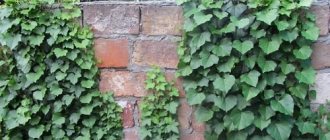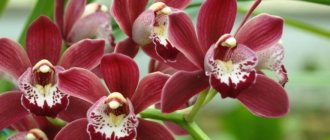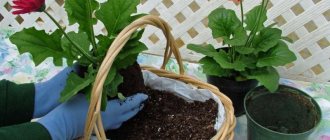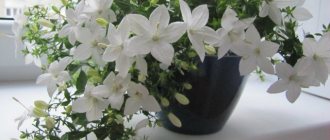How to propagate and root yucca?
Young offspring are most often obtained from an adult healthy plant. Already in the first years of cultivation, with proper care, a false palm tree can produce several shoots. Cuttings are rooted in water or wet sand. You can use expanded clay or specially formulated soil.
Components for soil mixture:
- washed sand - 1 part;
- humus (preferably leafy) - 0.5 parts;
- turf soil - 1 part.
Ready-made soil for rooting cuttings can be purchased at the store.
A plant planted in the ground forms its first roots within two months.
Experts recommend propagating indoor palm trees using one of the following methods:
- trunk parts;
- air layering;
- cut off top;
- offspring;
- seeds.
Vegetative propagation begins in April-May. This is a period of active growth for yucca, so rooting goes especially well. Separation of offspring is also best done in spring and summer or during transplantation of an adult bush.
Indoor yucca: propagation at home
In most cases, yucca reproduces vegetatively - that is, by parts of the plant. But you can also try planting flower seeds. The most popular growing methods are:
- seeds;
- air layering;
- part of the root;
- leaf.
Yucca indoors
All these methods are quite simple. The main thing is to plant correctly and provide further care so that the plant takes root as quickly as possible.
Reproduction by apex
From an adult plant, about 10-15 cm of the stem with the apical leaf rosette is cut off. The cut areas are treated with wood ash or crushed coal. The top stem is dried for 2-3 hours. Rooted in three ways:
- in wet sand, perlite, vermiculite;
- in a nutrient substrate (as for seeds);
- in warm boiled water with an activated carbon tablet.
Place a transparent bag over the container with the apical segment and place it in a shaded place with a temperature of about +20C. Water as needed to prevent the sand or substrate from drying out. The bag is removed for 30 minutes every day. At this time, the foliage is sprayed with a solution of fertilizers for succulents, and rotten leaves are removed.
After 1.5-2 months, roots will appear. The yucca is replanted, the pot with the plant is left in the shade for 2-3 days and then transferred to a sunny corner.
Methods and order of flower propagation
There are many different methods suitable for Yucca to reproduce at home, so we will talk about the main methods. All methods give positive results , the main thing here is to choose one that will suit a particular flower lover.
Seeds
Seeds can be purchased at shopping centers that sell ordinary flower seeds. Each such package, depending on the manufacturer, contains from 3 to 5 large seeds that are black in color and glossy in appearance.
To speed up seed germination, they need to be stratified ; for those who don’t know, this is damage to the seed coat. After which they are placed for cultivation in nutritious and loose soil. There is no need to deepen them too much, even 5 mm is enough.
Yucca seeds for planting
Germinating yucca seeds at home
The temperature in the room where Yucca will be grown from seeds should be at least 25 degrees Celsius. Therefore, many recommend sowing seeds when stable heat sets in. To prevent the bowl with seeds from drying out from high temperatures, place it in a transparent plastic bag or cover it with glass.
To prevent high humidity and temperatures from causing rotting, the bowl is ventilated daily, removing condensation from the glass as this is excess moisture.
When two true leaf plates emerge from the ground, the Yucca seedlings must be planted in different bowls, the size of which must strictly correspond to the size of the seedling’s root system.
IMPORTANT to know : in order to grow Yucca in this way you need to have a lot of patience, since an adult tree will only appear in a few years.
How to propagate yucca from tops
This is the most common method of plant propagation. Any rosette of leaves at the top or a randomly broken branch will do for this method. If the broken branch is too long, then part of the trunk is removed, leaving only a small piece of the trunk “heel”. This cutting is dried for a couple of hours and the lower leaf plates are removed.
Propagation of yucca by tops
After which the cuttings are planted in nutrient soil and covered with a glass jar, creating greenhouse conditions for the cuttings. You need to make sure that the soil is always slightly moist and does not dry out. But you shouldn’t fill it with water, as this will allow gray rot to appear on the cuttings.
The soil under a jar or bag dries out very slowly, so you need to be careful with watering.
Or the cuttings are placed in water to grow the root system. To prevent the cutting from rotting in water, add wood ash or 3 tablets of activated carbon.
This method is good for propagation when the flower has lost its root system for one reason or another.
Cuttings at home
Yucca cuttings are carried out either at the end of winter or beginning of spring , when the plant wakes up and begins to grow. Typically, cuttings are carried out on an adult plant when its crown is formed, removing excess shoots-cuttings. Since after pruning the lower part will stop growing, and the formed tree is unlikely to grow.
Yucca cuttings for replanting
Palm trees are pruned with pruning shears, after which the cuttings are dried for an hour and planted in mini-greenhouses with loose nutritious soil. After about a month and a half, young roots will appear, and then the cutting can be freed from greenhouse conditions, gradually accustoming it to room conditions.
The formation and growth of roots will be clearly visible if the cutting is planted in a transparent pot.
Lateral processes
To form layering, make an incision on the bark below the lower leaf plates by about 40 cm and remove the bark along the entire circumference, 1.5 cm wide. In the area where the bark is damaged, apply a layer of wet moss, and wrap the moss in polyethylene to prevent moisture evaporation . After a certain time, dormant roots wake up in this place, and as they grow, they form a cutting.
When the roots have grown so much that you can be sure that the layer will grow on its own, it is cut off with a sharp knife or pruning shears. The cut is treated with crushed activated carbon and planted in a substrate suitable for Yucca.
Lateral shoots of yucca before pruning
By shoots
This method involves the presence of root shoots or stem shoots . Separating excess shoots that thicken the mother plant is a completely necessary thing. After all, for the beautiful formation of a tree or bush, five sprouts of the same age are enough.
Therefore, excess sprouts are removed and all cuts are sprinkled with charcoal to prevent rotting. Then the sprouts are planted in coarse sand and placed in a mini-greenhouse to root them. Watering should be done so that the sand does not dry out. The greenhouse is ventilated and condensation is removed daily.
With proper care, the first roots will appear only after a month and a half. After which the sprout is transplanted as an independent plant into a separate container with nutritious soil.
Young yucca shoot
Stem cuttings
This propagation method is only suitable for experienced gardeners . After the tops are cut off, stems without leaf plates remain on Yucca. The trunk itself must be at least 25 cm long and all its cuts must be treated with garden pitch or, if it is not available, then with crushed activated carbon.
After this treatment, a second treatment is done with any stimulator of root mass formation. After all these procedures, the trunk must be transplanted into nutrient soil.
It is important to plant it as it was before cutting off the crown, that is, in the place where it grew upward. Therefore, one end should be marked so as not to confuse the ends and to place it in the right direction.
Usually, with this method of propagation, two buds, less often than three, appear at the top. To stimulate the appearance of these buds, you can spray the plant with the following preparations:
- Zircon
- Epin
- Cytokinin paste
Methods for planting a yucca trunk during transplantation
The first growing almost yuccas after transplantation
After the growing buds appear, you need to start feeding the plant with nitrogen fertilizers. This is done so that the plant has enough strength to grow a full head of hair or several tops. In this case, the container with such a plant should be in a bright place, but without direct sunlight. And if necessary, it must be turned towards the light so that the top of the Yucca grows evenly.
Air layering
This method is used when Yucca is rehabilitated after an illness . For propagation, only hard areas without rot are selected and the lower cut is cleared of the bark, removing 5 mm of it. stripe.
Be sure to have sphagnum moss on hand to cover the lower cuts.
The moss will need to be moistened periodically to create an appropriate microclimate around the cutting. After about a month, the first small roots will appear, which should thus be grown to a length of 5 cm.
After growing the roots in this way, the Yucca is planted in a new soil suitable for it and watering is carefully monitored so that rotting does not start again.
Propagation by cuttings
Part of the stem is sawed off and divided into several parts up to 20 cm long. The sections are disinfected. The cuttings are dried in the fresh air for 2-3 hours.
Work order:
- Pots or a deep container are filled with a mixture of sand and peat (1:1).
- The lower end of the cutting is buried 3-5 cm into the moist substrate. It is convenient to use pots here. The second option is to place the cuttings horizontally in a container. They are lightly pressed into the substrate, but not covered on top.
- The pots are covered with transparent bags or plastic balloons. The containers are covered with film.
- Greenhouses are placed in the shade, ventilated daily, and maintain moderate substrate humidity and a temperature of about +20C.
- With the appearance of buds, the shelter is removed, and the plant is fed with any nitrogen fertilizer.
- After 2 months, the yucca is transplanted. Horizontal petioles are first divided into parts according to the number of sprouts. Each part is placed in a separate pot.
Basic rules for growing yucca
Yucca comes from the tropics and subtropics, which indicates the heat-loving nature of the plant and the special regime for its maintenance. It is not recommended to place a palm tree on a windowsill, especially since it will be problematic as it grows, and the flower will not have enough light on the floor. The best option is to place it near the window on a stand that reaches the edge of the window sill. For this purpose, choose the south-eastern or south-western sides, while the southern windows are shaded.
In summer, the false palm, as yucca is also called, can be taken out into the fresh air, while protecting it from drafts. If there is a large difference between night and day temperatures, then it is better to take the flowerpot indoors at night. Lighting needs to be diffused: direct sunlight is not desirable.
In winter, the flower pot should be removed away from heating devices: overheating and dry air have a bad effect on the health of the flower. At the same time, you need to provide the plant with an additional light source, otherwise the plant trunk will stretch. Daylight hours for yucca should last at least 10 hours.
The required temperature in summer is +23...+26°C, in winter - +18...+20°C. The air humidity in the holding room should be 50–60%. You can maintain the desired level by spraying around the plant. The plant does not like dry, stagnant air, but when ventilating the room, do not forget that drafts and sudden changes in temperature are detrimental to it.
Did you know? American manufacturers use filamentous yucca fibers to make paper and rope.
Fibers are also added to fabric for sewing denim clothing, which increases its wear resistance.
Reproduction by shoots
Root and stem shoots are suitable for propagation. It is more convenient to root sprouts in water. An activated carbon tablet will prevent rotting. Fresh aloe juice stimulates root growth (5-7 drops per 200 ml). Add water as needed or change it when it becomes cloudy.
Shoots can be rooted in wet sand, perlite and nutrient substrate. They are buried 1-3 cm and create a greenhouse effect. Standard care: daily ventilation, maintaining optimal humidity and temperature. When roots appear, the plants are replanted.
Tops
If you provide proper care at home, yucca will grow and develop well. If desired, you can also ensure that the plant has several tips that can be used for propagation. The upper part is carefully cut off. In this case, there must be leaves on it.
The cut area is treated with charcoal. After some time, young shoots should appear on it, and the top is used as a false tree. After harvesting, the cut part is kept in fresh air for two hours, after which it is placed in water or moistened sand. In the first case, the liquid must be boiled and cooled. As soon as the root system is formed in the lower part, the top can be transplanted into a pot or open ground. If during germination the leaves begin to rot, they are removed and the substrate is replaced with fresh one.
Propagation by seeds
Yucca blooming indoors is a rare occurrence. In nature, the plant is pollinated by a symbiont insect (yucca moth). At home, seed pods do not form. Flower growers buy ready-made seeds (3-5 pieces per package). The seeds have a dense, glossy black shell. The average seed size is about 5 mm. Without pre-treatment they germinate in a month.
Work order:
- Suitable containers are small pots, a tall plastic container with drainage holes.
- The nutrient substrate is a mixture of turf (2) and coniferous (2) soil with coarse sand (2) and humus (1). Ready-made soil for succulents or palm trees is suitable.
- Scarification of seeds will reduce the germination period to 2 weeks - their shells are slightly ground off with sandpaper and kept in a growth stimulator for a day.
- A centimeter layer of drainage is poured into the container and filled with soil. The seeds are buried 5 mm into moist soil.
- The container is closed with a lid or covered with film. The greenhouse maintains moderate soil moisture, the temperature is not lower than +25C and is ventilated daily.
- When the first leaf develops, the seedlings are planted in separate pots with a volume of up to 100 ml. After the formation of 5 full leaves, the yucca is transplanted into a container 2 cm wider than the volume of the root system.
Yucca diseases and their treatment
Indoor Yucca is quite hardy, rarely gets sick, and endures ailments with steadfastness. It’s just important not to miss the moment of defeat. The health of Yucca is usually judged by its leaves. Any change in their color or shape should alert you.
If the leaves are covered with large light brown spots, you may have been too carried away with watering and spraying the flower. Due to waterlogging of the substrate and air space, a fungus has settled on the Yucca leaves. All leaves affected by the fungus must be removed. Treat the plant with some fungicide against a fungal disease (Topaz, Maxim, Cabrio). Move the pot to a room with lower humidity. Stop spraying the flower and the air around it.
If the fungus has infected not only the leaves, but also the stem of the Yucca, most likely the plant cannot be saved. You will have to get rid of it so that the disease does not spread to other flowers in your collection.
If the tips of the leaves of a seemingly healthy Yucca dry, this is a signal that the plant does not have enough moisture when watering or there is dry air in the room. Adjust watering, if necessary, start spraying the room and flower.
If brown spots appear on the leaves, dry and brittle to the touch, this is a reason for more frequent watering in the hot season. It seems that you often forget about watering and dry out the substrate too much. The plant needs watering after the top layer of the substrate has dried 5–7 cm.
If the spots on Yucca leaves are light in color, then this is a signal of an excess of sunlight. You should move the pot to light partial shade or shield the flower from direct sun with blinds or a curtain.
If the Yucca leaves droop and begin to lose their elasticity, their ends begin to curl and wither, your beauty may be freezing. Move it to a warmer room, or find a place in the same room, but closer to the radiator or away from the window glass.
If the lower leaves of Yucca turn yellow and dry, and the upper leaves continue to grow actively, then you should not worry - this is a normal process. The life of Yucca leaves lasts two years, then they die. Damaged lower leaves should be carefully disposed of (not torn off, but cut off) to maintain the decorative appearance of the flower. Due to the falling of the lower leaves in its natural environment, the Yucca becomes exactly like the Palm tree.
This may be interesting: Caring for Philodendron at home
But, if the plant begins to shed many lower leaves at once, pay attention to its care. Perhaps the flower is in a draft, or the room temperature is too low.
Reproduction by air layering
This method will help preserve the healthy part of the dying yucca. Work order:
- The trunk is stripped of bark around its circumference, with a strip of 1-1.5 cm. If the plant is sick, the bark is removed 10 cm above the affected area.
- The area where the bark is cut is wrapped in a layer of damp sphagnum moss, covered with film and fixed.
- In addition to regular care, make sure that the moss does not dry out.
- After a month, check the degree of root development. They should be strong, from 2 to 5 cm long.
- The cuttings are separated from the mother bush and rooted in the ground.
Growing
To grow a yucca palm tree, you don’t need any special knowledge, but to get a quality flower you should follow some rules. The article will discuss the cultivation of the most popular species - Yucca elephantis.
Landing
The finished plant can be purchased at a specialty store. Then you just need to transplant it into a permanent container. You can root the cuttings yourself at home. Potting soil can also be purchased. There is a special substrate for yucca, dracaena and palm trees.
You can prepare your own mixture for planting. To do this take:
- turf soil and rotted pine needles or leaves, 1 part each;
- coarse river sand - 1.5 parts;
- humus - 0.5 parts.
Advice! Peat can be added to the leaf part, and humus can be replaced with vermicompost purchased at the store.
Large plants require denser soil, so it contains almost 50% turf soil. For planting, you must choose a deep pot, at the bottom of which drainage must be placed. The width of the container should be spacious so that the root fits freely in it, and there is still 1.5 cm of space left to the walls.
Watch the video! Homemade yucca. Yucca propagation and planting in a pot
Watering
For watering yucca, you should use only settled water in order to prevent the soil from acidifying. Peat can be used to soften water.
- Place 100 g of the substance in a cloth napkin;
- We lower it into a 10-liter bucket filled with water;
- After a day, you can water the plant with this infusion. In addition, it will serve as a light mineral supplement.
How often to water?
- The frequency of watering depends on the age of the yucca. The larger the plant, the less often watering is required. The volume of land should also be taken into account. It will dry much faster in a 5-liter container than in a 15-20 liter pot.
- The time of year also affects watering. In summer, the palm tree is in an active growth stage, so it needs more liquid. But in winter it rests and requires almost no water. If the room is too hot, the soil in the pot dries faster.
- If the room temperature is high in winter and there is no way to lower the temperature to 10–14 ° C, the soil will quickly dry out. If the humidity of the room in which the flower is located is low, it should be watered more often.
Top dressing
Accustomed to hot climate conditions, yucca is considered an unpretentious plant. In nature, she does not feel a lack of nutrition. But there is not enough of it in the pot, so the plant should be fed, especially from March to August. Fertilizer should be applied once every 15-20 days.
How can you feed indoor yucca?
Today there is no shortage of fertilizers. Special fertilizers are produced for each type of plant, including palm trees and yucca.
- Complexes of mineral fertilizers for palms, yuccas, dracaenas from companies such as Master, Flower Paradise, Biopon.
- Mineral-organic fertilizers based on humic acids with the addition of microelements produced by Zontik, Absolut, Gumisol-M.
- Complex fertilizers for decorative deciduous indoor plants. This solution is too concentrated, so it should be diluted almost 3 times the manufacturer's recommendations.
- Organic fertilizers, for example, granulated horse manure (“Orgavit”).
- There are foliar fertilizers for treating the underside of leaves.
In winter, the plant rests, so it does not need feeding. Also, do not apply fertilizer after transplantation if it is affected by diseases and harmful insects.
Trimming
Pruning yucca is done in order to give the plant an interesting shape. Without it, the trunk of the home beauty stretches out, and at its top there is a bunch of leaves. The plant can begin to form when its trunk reaches a diameter of 5 cm and a height of 60–70 cm.
Advice! The best time for pruning is spring. Before starting such a procedure, the plant should be well watered.
During the first pruning, the top of the yucca is cut off, leaving a trunk about 40–50 cm high. The cut site is first dried, and then garden varnish, melted paraffin is applied to it, or sprinkled with wood ash or activated carbon powder.
As a result of pruning, the development of several axillary buds (up to 5 pieces) is activated at once. It is necessary to leave those that will give the necessary second-order trunks. Other buds are cut off and can be used to propagate the culture.
Important! It is worth noting that if the trunk thickness is more than 6 cm, you can leave up to 4 shoots. A thin trunk can only support two shoots.
After the sprouts have already developed, you can begin to form second-order trunks. At the same time, the formation of each branch is done one by one. A pseudo palm tree can grow 10-15 cm in a year.
Transfer
Homemade yucca is transplanted in three cases:
- Transferring a plant from a store container to a permanent pot;
- Planned transplantation is carried out once every 2–3 years;
- An unscheduled procedure is needed when the plant root is damaged.
A planned transplant is necessary as the flower grows and requires improved living conditions.
- When the vase for the plant is already small, it is not difficult to determine. If it is unstable, the flower can fall over at any minute.
- The roots have filled the entire container with soil, and they can already be seen in the holes below.
- You can also notice that the leaves have stopped growing, and water is poorly absorbed when watering.
As a rule, yucca transplantation is organized in the spring. Before starting the procedure, you should purchase a larger vase, prepare new soil, the same as for planting, and drainage material. A few days before the event, stop watering the plant. If the substrate in the pot is bad, it will be easier to remove it this way. If the mixture is still good, then you can remove the top part of the earthen clod.
Before transshipment of a palm tree, it is necessary to inspect the condition of the roots, which should be strong and light-colored. Soft and dark pieces of root must be removed by cutting them down to living material. The wounds should be rubbed with activated carbon.
Elephant Yucca can not be replanted as often as other specimens. In a tight container, it develops slowly, some leaves dry out, while others grow, and a beautiful trunk is formed. With a large amount of soil, the root system and leaf cover develop quickly, and the trunk grows poorly.
Watch the video! Yucca transplant
Reproduction by offspring
With proper care, yucca can have children in the first year of life. Separating root or stem shoots from a false palm tree is even useful - for normal growth and development, you need to ensure that there are no more than five shoots on the plant at the same time.
The process of rooting children is as follows:
- It is advisable to sprinkle the cuts on the parent tree and on the offspring itself with crushed charcoal;
- separated offspring must be planted in containers with damp, clean sand, watered and covered with a glass jar or plastic bag;
- It doesn’t hurt to provide young plants with good humidity and a temperature of at least 20 °C;
- it is very important to ventilate the “greenhouse” daily and water the plant as needed;
- root formation will occur in a period of approximately two months;
When the yucca has taken root, you need to transplant it into a permanent pot with good soil and pieces of charcoal in it.
Propagation of yucca by cuttings and stem sections
Propagation of yucca at home becomes a necessity during long-term maintenance, since the indoor plant grows excessively. The root system is not always able to provide moisture and nutrients to the rapidly growing crown; as a result, yucca needs pruning and cuttings.
This plant is unpretentious in maintenance and can be propagated without problems. Growing elephant yucca often begins with a small cutting or small piece of stem that is germinated to produce young shoots.
Yucca is propagated vegetatively: by apical cuttings, parts of the trunk, and rooting of offspring. How to properly trim and root yucca at home.
1. Cut off the top with leaves, expose the lower part of the trunk, sprinkle the cuts with crushed coal or activated carbon powder, dry for 1-2 hours in the open air, then plant for rooting in the ground or in wet sand, vermiculite. Cut off the lower leaves on the trunk. After a month, roots begin to form. After another month, we plant the plant in the soil mixture.
In the photo: the upper part of the yucca has safely taken root in the substrate and is already growing a new leaf - domfloris.ru.
2. Cut the middle part of the stem without leaves into pieces at least 20 cm long and use them for propagation as cuttings. Sprinkle the cut with crushed coal, dry it and root it in a substrate (a mixture of peat and sand) or a container with boiled water (you can add a root former and activated carbon.)
I kept parts of the yucca stem in water for a day, then planted them in the ground for root development.
A shoot appeared on one cutting, which means rooting was successful...
3. Place the lower part with the roots that remains in the pot in a well-lit place and water it moderately. If necessary, you can hold it for a while under a transparent cap or glass jar, thus creating humidity. When new buds develop on the uterine segment, we transplant it into a fresh substrate for further growth.
The remaining part of the yucca plant has already sprouted and a second one has hatched... Photo: domfloris.ru
Excess shoots on the stem should be removed and trimmed (leave 2-3), even if you do not need new specimens, this way the yucca will grow better and form the crown correctly. The suckers, which reach a length of about 10 cm, can be cut off with a sharp knife to produce new plants. Grown sprouts easily take root in the wet sand of a mini-greenhouse in spring and summer. It should be regularly ventilated and moistened until roots appear.
You can place cuttings, sprouts, sprays in a jar of water, where you put a piece of charcoal to prevent rot. When the roots appear, after about a month, transplant into a pot with prepared soil.
Optimal timing for reproduction
Seed propagation is carried out immediately after collecting the seeds, since they quickly lose their ability to germinate. Vegetative propagation is carried out from April to June. In the spring, during the period of active growth, cuttings and apical shoots take root well. Separation of offspring is carried out both in spring and summer if it is necessary to replant the plant.
Basic requirements for capacity:
- the presence of holes for water drainage;
- volume corresponding to the size of the root system.
How to plant yucca?
Yucca is unpretentious and hardy. It is not afraid of drought, heat and wind, but the plant’s main enemy is waterlogging and heavy soils, where there is a risk of moisture stagnation.
To simplify the care of garden yucca, in the photo, planting is carried out in a well-ventilated sunny place. When choosing a site for an exotic beauty, you should avoid lowlands and corners of the garden with dense shade. A long stay in partial shade leaves a mark on the appearance of the crop. The leaves lose their former density, the trunk stretches. As a result, the plant looks quite untidy even when receiving full care.
Yucca has no special requirements for soil composition. The main thing is that the roots receive enough air and water does not linger in the soil. Therefore, before planting yucca, in areas with dense black soil or clay, sand is added to the substrate to fill the hole. A drainage layer is needed at the bottom, and to provide nutrition, especially on poor soils, humus is added to the substrate.
Despite the unpretentiousness of the culture, it will not be possible to do without any care after planting yucca in open ground.
Care after breeding
Further care consists of standard procedures for indoor plants. Care rules:
- Watering - young plants are watered in small portions, not allowing the top layer of soil to dry out. Adult specimens are watered once a week in the warm season, and once every 2-3 weeks in the autumn-winter season. Experienced gardeners recommend calculating the amount of moisture based on the volume of soil - 1 liter of water per 4 liters of soil. Excess moisture is drained from the pan to prevent rotting of the roots. In the summer, to wash away dust from the foliage, bathe the plant once a month under a warm shower.
- Feeding is carried out in the spring and summer. For fertilizer, special liquid formulations for palm trees are used, for example, “Stimovit”. The drug is diluted with water in a proportion twice as large as indicated in the instructions. Apply once every 2-3 weeks, spraying the green part.
- Pruning - formative pruning is carried out after the yucca leaves the dormant period. You can trim an adult plant whose trunk diameter is at least 2 cm. Pruning is carried out with pruning shears at a distance of 40 cm from the soil surface. The cut is treated with crushed coal and filled with wax to prevent rotting. The procedure stimulates the formation of lateral shoots and creates growth in several trunks.
- Transplantation - young plants are replanted annually, adults - once every 3-4 years. The procedure is carried out in the spring using the transshipment method.
For a month, the yucca is not disturbed by care procedures (except for watering): it must take root and adapt.
Methods of transplanting and transplanting Yucca
In order for Yucca to grow well, it needs replanting; young plants are replanted annually; in old plants, only the top layer of soil can be renewed.
Yucca before transplantation
Land preparation
The soil can be purchased ready-made at garden centers or you can make it yourself. The main thing is that it is nutritious and loose enough to allow air to flow to the root system. You can make this mixture, taking everything in equal parts:
- Chernozem
- Peat
- Sod land
- Sand
Details about proper transplantation
| 1. | Container for Yucca | Any container will do, as long as it matches the size of the plant’s root system. It should have drainage holes to drain water. |
| 2. | Drainage | Drainage is necessary to avoid root rot. Typically, expanded clay is used for this purpose, which is sold in flower shops in the department along with the soil. It is poured in a layer of 2 cm. |
| 3. | Planting a plant | After drainage, a handful of soil is poured onto which the Yucca is installed. The roots should be evenly spread in different directions. After that, soil is poured evenly on all sides and pressed with hands around the circumference of the pot to remove air voids. |
| 4. | Watering | It is better to water after a day; this time will allow the wounds on the injured roots to heal. This will reduce the risk of root rot. |
Frame to support yucca after transplantation
What is the difference between planting in a pot and in open ground?
Actually, the only difference is that in open ground all transplanting manipulations are done only in the spring before the onset of heat or in early autumn , so that by the cold weather the plant takes root and adapts to the new place.
Indoors, replanting and transshipment of flowers can be done at almost any time. We can say that even in winter, if a flower needs help and needs an urgent transplant, then it has a chance to reschedule it. It is only necessary that the temperature be 25 degrees Celsius and additional lighting for the flower.
Errors
Sometimes failures occur when transplanting Yucca, here are some that could have been avoided if you used the tips correctly.
Withering yucca leaves after improper replanting
- There should always be drainage .
- The container where Yucca will be planted must have drainage holes to drain water.
- The soil should be loose and nutritious .
- Watering is strictly regulated.
- The temperature should not be lower than 25 degrees Celsius.
Only if you follow all the instructions will rooting be successful.
How to root a flower
After transplanting into new soil, the plant requires absolutely no fertilizing. The first watering with fertilizers should be carried out when Yucca begins its active growth and a month after transplantation. Watering must also be adjusted, since constant moistening will not give a positive result. The soil should dry out by one third of the pot between waterings. The place should not be too sunny, the light should be diffused.
Yucca after successful transplantation
If a month after transplantation the plant feels good, then the transplantation was successful.
Yucca can be propagated at home. You just need to follow the necessary recommendations and everything will work out. As a result, there will be one or many young bushes of the wonderful Yucca.
False Yucca palm tree: methods of propagation, proper planting
An evergreen exotic plant , resembling a palm tree in appearance, has taken root well in apartments, office spaces, and greenhouses.
With its spectacular appearance and unpretentiousness in maintenance, yucca has won a large number of fans among lovers of indoor floriculture.
Yucca flower: propagation, photo, planting, cultivation, replanting and care.
Reproduction in open ground
Garden species are easy to propagate. But for this the conditions must be met:
- the plant should grow in a sunny place protected from the wind;
- time – April, May.
Ideally, replace garden soil with a special nutrient mixture. You can plant yucca only when it is accustomed to street conditions. To do this, it is necessary to take it out into the open air every day, increasing the periods of time spent there.
After purchase, the garden type is planted in a flowerbed. To do this, choose a clearing that is well lit by the sun, but without wind. To plant a young specimen, it is necessary to prepare a hole with dimensions of 60 (depth) by 80 (width). If the plant is mature, the depth is increased by 10-20 cm.
A suitable primer consists of the following components:
- sand;
- fine gravel;
- black soil;
- compost.
The ingredients are mixed in equal parts and moistened. 40% of the substrate is poured out immediately, then the plant is installed, after which the rest of the soil is poured out. A compaction is made, forming a small hole into which warm water is poured.
In the first week after transplanting garden yucca, it must be sprayed daily.











